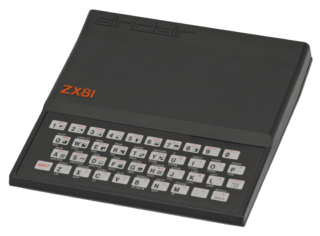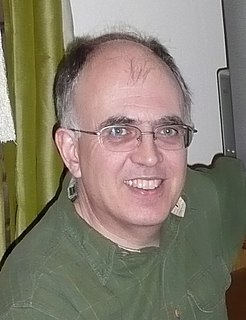Related Research Articles

The Jupiter Ace by Jupiter Cantab was a British home computer of the early 1980s. The Ace differed from other microcomputers of the time in that its programming environment used Forth instead of the more popular BASIC.
The Sinclair QL is a personal computer launched by Sinclair Research in 1984, as an upper-end counterpart to the ZX Spectrum. The QL was aimed at the serious home user and professional and executive users markets from small to medium-sized businesses and higher educational establishments, but failed to achieve commercial success. While the ZX Spectrum has an 8-bit Zilog Z80 as the CPU, the QL uses a Motorola 68008. The 68008 is a member of the Motorola 68000 family with 32-bit internal data registers, but an 8-bit external data bus.

The Sinclair ZX80 is a home computer launched on 29 January 1980 by Science of Cambridge Ltd.. It is notable for being one of the first computers available in the United Kingdom for less than a hundred pounds. It was available in kit form for £79.95, where purchasers had to assemble and solder it together, and as a ready-built version at £99.95. The ZX80 was very popular straight away, and for some time there was a waiting list of several months for either version of the machine.

The ZX Spectrum is an 8-bit personal home computer developed by Sinclair Research. It was first released in the United Kingdom on 23 April 1982 and went on to become Britain's best-selling microcomputer.

The ZX81 is a home computer that was produced by Sinclair Research and manufactured in Dundee, Scotland, by Timex Corporation. It was launched in the United Kingdom in March 1981 as the successor to Sinclair's ZX80 and designed to be a low-cost introduction to home computing for the general public. It was hugely successful; more than 1.5 million units were sold. In the United States it was initially sold as the ZX-81 under licence by Timex. Timex later produced its own versions of the ZX81: the Timex Sinclair 1000 and Timex Sinclair 1500. Unauthorized ZX81 clones were produced in several countries.
Jupiter Cantab Limited was a Cambridge based home computer company. Its main product was the 1983 Forth based Jupiter Ace.
Sinclair BASIC is a dialect of the programming language BASIC used in the 8-bit home computers from Sinclair Research and Timex Sinclair. The Sinclair BASIC interpreter was made by Nine Tiles Networks Ltd.

The Enterprise is a Zilog Z80-based home computer announced in 1983, but through a series of delays, not commercially available until 1985. The specification as released was powerful and one of the higher end in its class. This was due to the use of ASICs for graphics and sound which took workload away from the CPU, an extensive implementation of ANSI BASIC and a bank switching system to allow for larger amounts of RAM than the Z80 natively supported. It also featured a distinctive and colourful case design, and promise of multiple expansion options. Ultimately it was not commercially successful, after multiple renames, delays and a changing market place. Its manufacturer calling in the receivers in 1986 with significant debt. It was developed by British company Intelligent Software and marketed by Enterprise Computers. Its two variants are the Enterprise 64, with 64 kilobytes of Random Access Memory (RAM), and the Enterprise 128, with 128 KB of RAM.
Sinclair Research Ltd is a British consumer electronics company founded by Clive Sinclair in Cambridge. It was originally incorporated in 1973 as Westminster Mail Order Ltd, renamed Sinclair Instrument Ltd, then Science of Cambridge Ltd, then Sinclair Computers Ltd, and finally Sinclair Research Ltd. It remained dormant until 1976, when it was activated with the intention of continuing Sinclair's commercial work from his earlier company Sinclair Radionics, and adopted the name Sinclair Research in 1981.

3D Monster Maze is a survival horror computer game developed from an idea by J.K. Greye and programmed by Malcolm Evans and released in February 1982 for the Sinclair ZX81 platform with the 16 KB memory expansion. The game was initially released by J. K. Greye Software in early 1982 and re-released later the same year by Evans' own startup, New Generation Software. Rendered using low-resolution character block "graphics", it was one of the first 3D games for a home computer, and one of the first games incorporating typical elements of the genre that would later be termed survival horror.

Artic Computing was a software development company based in Brandesburton, England from 1980 to 1986. The company's first games were for the Sinclair ZX81 home computer, but they expanded and were also responsible for various ZX Spectrum, Commodore 64, BBC Micro, Acorn Electron and Amstrad CPC computer games. The company was set up by Richard Turner and Chris Thornton. Charles Cecil, who later founded Revolution Software, joined the company shortly after it was founded, writing Adventures B through D. Developer Jon Ritman produced a number of ZX81 and Spectrum games for Artic before moving to Ocean Software.

Cauldron is a two-dimensional (2D) shoot 'em up/platformer computer game developed and published by British developer Palace Software (Palace). The game was released in 1985 for the ZX Spectrum, Commodore 64 and Amstrad CPC home computers. Players control a witch, who aims to become the "Witch Queen" by defeating an enemy called the "Pumpking".
Crystal Computing, later renamed Design Design, was a British video game developer founded in 1982 by Chris Clarke and Ian Stamp while students at the University of Manchester. Graham Stafford, Neil Mottershead, Simon Brattel and Martin Horsley, joined the company as it expanded. The company's first software release was a compilation of games for the Sinclair ZX81, though it was with the ZX Spectrum that Crystal found its greatest success. A deal with the machine's manufacturer Sinclair to distribute Crystal's Zeus Assembler gave the company sufficient funds for a major marketing campaign for their next product, Halls of the Things, an arcade adventure game that became their most successful title.

Steve Vickers is a British mathematician and computer scientist. In the early 1980s, he wrote ROM firmware and manuals for three home computers, the Sinclair ZX81 and ZX Spectrum and the Jupiter Ace. The latter was produced by Jupiter Cantab, a short-lived company Vickers formed together with Richard Altwasser, after the two had left Sinclair Research. Since the late 1980s, Vickers has been an academic in the field of geometric logic, writing over 30 papers in scholarly journals on mathematical aspects of computer science. His book Topology via Logic has been influential over a range of fields. In October 2018, he retired as senior lecturer at the University of Birmingham. As announced on his university homepage, he continues to supervise PhD students at the university and focus on his research.

Football Manager is the first game in the Football Manager series.

The ZX Spectrum character set is the variant of ASCII used in the British Sinclair ZX Spectrum family computers. It is based on ASCII-1967 but the characters ^, ` and DEL are replaced with ↑, £ and ©. It also differs in its use of the C0 control codes other than the common BS and CR, and it makes use of the 128 high-bit characters beyond the ASCII range. The ZX Spectrum's main set of printable characters and system font are also used by the Jupiter Ace computer.

The Real Ghostbusters is a 1987 shoot 'em up arcade game developed and published by Data East in the United States. It is loosely based on the animated series of the same name. In Japan, Data East released it as a non-Ghostbusters arcade game under the title Meikyuu Hunter G. In 1989, Activision published The Real Ghostbusters for Amiga, Amstrad CPC, Atari ST, Commodore 64, and ZX Spectrum.

Ace is a combat flight simulator video game published for the Commodore 64, VIC-20, and Plus/4 in 1985 by Cascade Games. It was ported to the Amstrad CPC, Amstrad PCW, Amiga, and ZX Spectrum.
References
- ↑ "Find My Past" . Retrieved 12 August 2016.
- 1 2 3 4 Your Computer, ed. (July 1982). "The Engineer Behind The Spectrum". Archived from the original on 16 March 2012. Retrieved 14 May 2011.
- ↑ Sinclair User, ed. (July 1982). "Secret plans laid by new company". Archived from the original on 16 May 2011. Retrieved 14 May 2011.
- ↑ Popular Computing Weekly, ed. (August 1982). "Spectrum team deal their Ace" . Retrieved 14 May 2011.
- ↑ "An Interview with ZX Spectrum Designer Richard Altwasser". October 2018.
- ↑ "Jupiter Ace Resource Site - Buyers Guide Home Computing Weekly November 1983".
- ↑ Popular Computing Weekly, ed. (3 November 1983). "Jupiter hits the dust" . Retrieved 14 May 2011.
